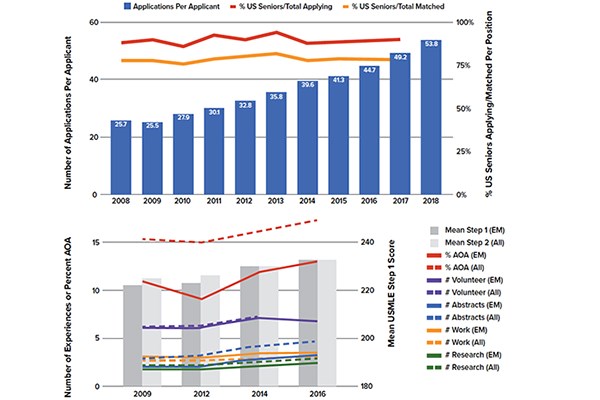Congratulations to the Medical School Class of 2018!
Every year on the third Friday of March, medical students across the country open their “Match Day” envelopes and (hopefully) breathe a sigh of relief to discover they will be training at one of their top-choice programs. Across all specialties, half of all U.S. seniors will end up with their top-ranked program, and three-quarters of seniors will end up with one of their top three choices.
Over-application & Filters
The percentage of students matching at their preferred programs has remained very stable over the past several years. Unfortunately, a number that has NOT remained stable is the number of emergency medicine programs that students are applying to. Today, students are applying to twice the number of residency programs than they were a decade ago: 53.8 in 2018, compared to only 25.7 in 2008. And while it’s not entirely clear what’s driving this phenomenon, program directors — now inundated with more applications than ever before — are forced to resort to filtering applications, and new tools like the AAMC Standardized Video Interview are being piloted to help select applicants with the right skill sets to become excellent emergency physicians.
EM Is Average
Why are students doing this? The most common response I hear is “because emergency medicine is becoming more competitive.” However, I have yet to find any convincing evidence that this widely held belief is true. Approximately 4 out of every 5 EM residency spots continues to be filled by U.S. seniors each year, and over the past decade, the four NRMP “Charting Outcomes in the Match” reports that have been released show that mean Step 1 scores and number of volunteer and work experiences for EM applicants remain average. In fact, EM consistently falls below average in terms of the percentage of Alpha Omega Alpha members matched and the average number of research experiences and abstracts/posters presented.
Apply Smarter, Not Harder
While the NRMP’s “Charting Outcomes” helps students predict their likelihood of matching based upon the number of programs on their rank list, it doesn’t help students understand the number of programs they need to apply to in order to secure enough interviews to build a rank list that will guarantee a match. This is where the AAMC’s new Point of Diminishing Returns figures come into play. For example, students with low Step 1 scores (<=215) applying to EM will experience diminishing returns after 32 programs, while students with Step 1 scores at or above the national average (>=234) will experience diminishing returns after only 18 programs. Students should seek the advice of a trusted advisor to fine-tune their application strategy, based upon their individual goals and competitiveness, rather than scattershooting for residency positions.
EMRA Match for Clerkships
For students heading into their final year of medical school, spring is the season to secure away rotations. Approximately 20% of career-track, adult EM away rotations are not listed on VSAS. Fortunately, EMRA is here to help with the launch of our new EMRA Match for Clerkships, a collaborative, filterable, crowd-sourced clerkship directory created with our friends at CDEM, CORD, and ACEP. Students will also be able to learn:
- Which sites offer subspecialty rotations or diversity externship scholarships?
- Which rotations require Step 1/COMLEX?
- Is a car recommended?
- Is there an on-site housing option?
Easily sort through hundreds of opportunities to find the one that’s right for you!



